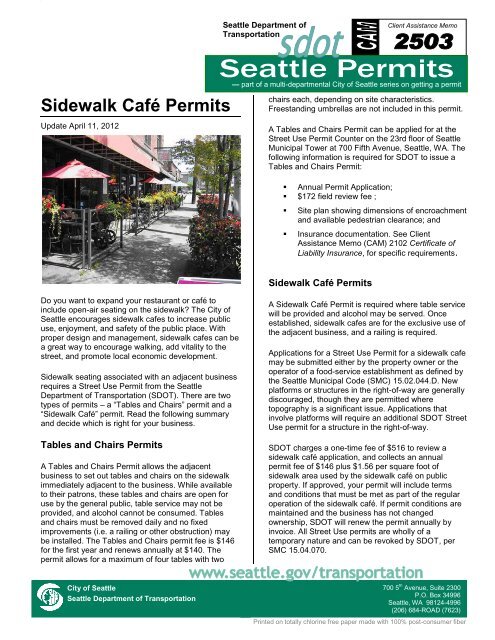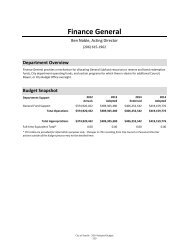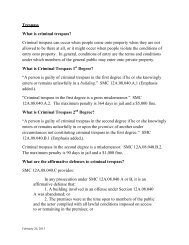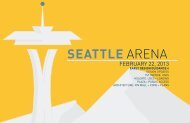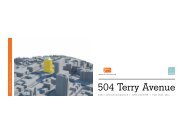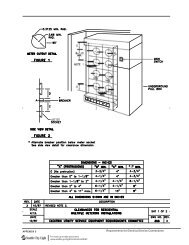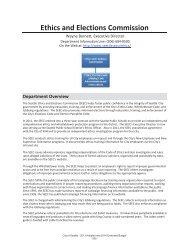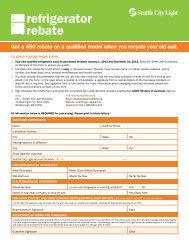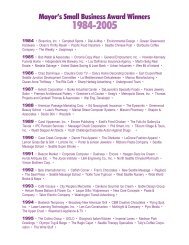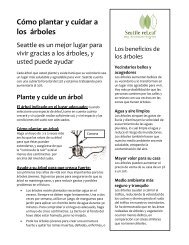Sidewalk Café Permits - City of Seattle
Sidewalk Café Permits - City of Seattle
Sidewalk Café Permits - City of Seattle
Create successful ePaper yourself
Turn your PDF publications into a flip-book with our unique Google optimized e-Paper software.
1<br />
<strong>Sidewalk</strong> <strong>Café</strong> <strong>Permits</strong><br />
Update April 11, 2012<br />
Do you want to expand your restaurant or café to<br />
include open-air seating on the sidewalk? The <strong>City</strong> <strong>of</strong><br />
<strong>Seattle</strong> encourages sidewalk cafes to increase public<br />
use, enjoyment, and safety <strong>of</strong> the public place. With<br />
proper design and management, sidewalk cafes can be<br />
a great way to encourage walking, add vitality to the<br />
street, and promote local economic development.<br />
<strong>Sidewalk</strong> seating associated with an adjacent business<br />
requires a Street Use Permit from the <strong>Seattle</strong><br />
Department <strong>of</strong> Transportation (SDOT). There are two<br />
types <strong>of</strong> permits – a “Tables and Chairs” permit and a<br />
“<strong>Sidewalk</strong> <strong>Café</strong>” permit. Read the following summary<br />
and decide which is right for your business.<br />
Tables and Chairs <strong>Permits</strong><br />
A Tables and Chairs Permit allows the adjacent<br />
business to set out tables and chairs on the sidewalk<br />
immediately adjacent to the business. While available<br />
to their patrons, these tables and chairs are open for<br />
use by the general public, table service may not be<br />
provided, and alcohol cannot be consumed. Tables<br />
and chairs must be removed daily and no fixed<br />
improvements (i.e. a railing or other obstruction) may<br />
be installed. The Tables and Chairs permit fee is $146<br />
for the first year and renews annually at $140. The<br />
permit allows for a maximum <strong>of</strong> four tables with two<br />
<strong>City</strong> <strong>of</strong> <strong>Seattle</strong><br />
<strong>Seattle</strong> Department <strong>of</strong> Transportation<br />
<strong>Seattle</strong> Department <strong>of</strong> Client Assistance Memo<br />
Transportation<br />
— part <strong>of</strong> a multi-departmental <strong>City</strong> <strong>of</strong> <strong>Seattle</strong> series on getting a permit<br />
chairs each, depending on site characteristics.<br />
Freestanding umbrellas are not included in this permit.<br />
A Tables and Chairs Permit can be applied for at the<br />
Street Use Permit Counter on the 23rd floor <strong>of</strong> <strong>Seattle</strong><br />
Municipal Tower at 700 Fifth Avenue, <strong>Seattle</strong>, WA. The<br />
following information is required for SDOT to issue a<br />
Tables and Chairs Permit:<br />
� Annual Permit Application;<br />
� $172 field review fee ;<br />
� Site plan showing dimensions <strong>of</strong> encroachment<br />
and available pedestrian clearance; and<br />
� Insurance documentation. See Client<br />
Assistance Memo (CAM) 2102 Certificate <strong>of</strong><br />
Liability Insurance, for specific requirements.<br />
<strong>Sidewalk</strong> <strong>Café</strong> <strong>Permits</strong><br />
A <strong>Sidewalk</strong> <strong>Café</strong> Permit is required where table service<br />
will be provided and alcohol may be served. Once<br />
established, sidewalk cafes are for the exclusive use <strong>of</strong><br />
the adjacent business, and a railing is required.<br />
Applications for a Street Use Permit for a sidewalk cafe<br />
may be submitted either by the property owner or the<br />
operator <strong>of</strong> a food-service establishment as defined by<br />
the <strong>Seattle</strong> Municipal Code (SMC) 15.02.044.D. New<br />
platforms or structures in the right-<strong>of</strong>-way are generally<br />
discouraged, though they are permitted where<br />
topography is a significant issue. Applications that<br />
involve platforms will require an additional SDOT Street<br />
Use permit for a structure in the right-<strong>of</strong>-way.<br />
SDOT charges a one-time fee <strong>of</strong> $516 to review a<br />
sidewalk café application, and collects an annual<br />
permit fee <strong>of</strong> $146 plus $1.56 per square foot <strong>of</strong><br />
sidewalk area used by the sidewalk café on public<br />
property. If approved, your permit will include terms<br />
and conditions that must be met as part <strong>of</strong> the regular<br />
operation <strong>of</strong> the sidewalk café. If permit conditions are<br />
maintained and the business has not changed<br />
ownership, SDOT will renew the permit annually by<br />
invoice. All Street Use permits are wholly <strong>of</strong> a<br />
temporary nature and can be revoked by SDOT, per<br />
SMC 15.04.070.<br />
700 5 th Avenue, Suite 2300<br />
P.O. Box 34996<br />
<strong>Seattle</strong>, WA 98124-4996<br />
(206) 684-ROAD (7623)<br />
Printed on totally chlorine free paper made with 100% post-consumer fiber
SDOT Client Assistance Memo #2503- <strong>Sidewalk</strong> <strong>Café</strong> <strong>Permits</strong> page 2<br />
A. Location and Standards<br />
To qualify for a sidewalk café permit, the public space<br />
adjacent to your food-service business must be a<br />
suitable site that meets all the setback and clearance<br />
requirements. The location must be approved by the<br />
Street Use Division <strong>of</strong> SDOT.<br />
The following setback and clearance standards apply<br />
to all sidewalk cafes. SDOT has the discretion to<br />
increase some <strong>of</strong> the distances or add specific<br />
conditions to the Street Use permit based on site<br />
characteristics. Street Use will decide the<br />
appropriateness <strong>of</strong> each requested location based on<br />
the following setback and clearance standards: For<br />
more detailed information, please see Director’s Rule<br />
4-2011.<br />
1. Zoning. All sidewalk cafes must be 50 feet from a<br />
residentially-zoned parcel (lots zoned RSL, SF<br />
5000, SF 7200, SF 9600, LR1, LR2, or LR3<br />
defined under SMC subsection 23.30.010.A; and<br />
the abutting zone does not have an RC designation<br />
as shown on the Official Land Use Map, Chapter<br />
23.32. The <strong>City</strong> <strong>of</strong> <strong>Seattle</strong> zoning map can be<br />
viewed at:<br />
http://www.seattle.gov/dclu/Research/gis/webplots/<br />
smallzonemap.pdf<br />
2. Clear Pedestrian Zone Area<br />
If your café extends into the sidewalk area, a<br />
designated pedestrian zone with a linearpedestrian-visual<br />
corridor is required adjacent to all<br />
sidewalk cafes. A clear pedestrian zone must be<br />
maintained at all times around the sidewalk cafe or<br />
tables and chairs. The pedestrian zone is<br />
measured from the outside edge <strong>of</strong> the sidewalk<br />
café fencing or fence post base to the nearest<br />
obstruction; for example, a tree pit, pay station,<br />
bike rack, sign post, or other similar object. If no<br />
obstruction exists, the pedestrian zone is<br />
measured to the back <strong>of</strong> the curb. The pedestrian<br />
visual corridor is within the pedestrian zone and<br />
dictates that the pedestrian zone must be generally<br />
straight and with no sharp or jagged turns that<br />
impair pedestrian circulation (see Figure 1:<br />
Pedestrian Zone/ Pedestrian Visual Corridor).<br />
In the Downtown Urban Center (see Map 1:<br />
Downtown Urban Center), a pedestrian zone at<br />
least 6 feet wide with a 4-foot-wide pedestrian<br />
visual corridor is required.<br />
Outside the Downtown Urban Center, a<br />
pedestrian zone at least 5 feet wide with a 3foot-wide<br />
pedestrian visual corridor is required.<br />
<strong>Sidewalk</strong> cafes may not encroach into tree pits<br />
or the corner-curb-radius area (see Figure 2:<br />
Corner Curb Radius Area).<br />
A sidewalk café width should not exceed the<br />
available pedestrian clear path <strong>of</strong> travel width.<br />
The Director may allow the sidewalk café width<br />
to increase if the Director determines that the<br />
pedestrian zone can extend into an adjacent<br />
public place closed to vehicular travel or a public<br />
place plaza.<br />
The Director may require more than the minimum<br />
pedestrian zone or pedestrian-visual-corridor<br />
widths in order to provide for pedestrian<br />
passage, traffic management, or any other public<br />
use purpose. Examples <strong>of</strong> where the Director<br />
may require more than the minimum pedestrianzone<br />
width include, but are not limited to:<br />
o Areas with high peak-period pedestrian<br />
volumes;<br />
o When analysis suggests a wider pedestrian<br />
zone is necessary;<br />
o When approved street-design plans call for<br />
additional width; or<br />
o When transit-loading zones, public plazas,<br />
art installations, and access points are<br />
present and large volumes <strong>of</strong> pedestrians<br />
circulate.<br />
Umbrellas, A-frame signs, portable signs,<br />
planters, or any other encroachment is not<br />
allowed in the pedestrian zone or pedestrian<br />
visual corridor. Umbrellas with a minimum<br />
clearance <strong>of</strong> 8 feet above the sidewalk grade<br />
may project over the pedestrian zone.<br />
Electrical cords or strings <strong>of</strong> lights may not be<br />
strung over or be placed on the pedestrian zone.<br />
3. Setbacks. Setbacks are required from the<br />
following elements and must be clearly identified<br />
on the required site plan for the Street Use permit<br />
application (see Figure 3: <strong>Sidewalk</strong> <strong>Café</strong> Location):<br />
5 feet from alleys, driveways, bus zone areas,<br />
disabled person parking zones, and commercial<br />
loading zones;<br />
5 feet from curb ramps, parking meters or<br />
parking pay stations, traffic signs, SDOT and<br />
utility poles, fire hydrants, bike racks, and other<br />
street fixtures;<br />
If the sidewalk café is adjacent to the curb:<br />
3 feet from the front <strong>of</strong> the curb;<br />
10 feet along the curb line from the point where<br />
the radius <strong>of</strong> the corner-curb area intersects the<br />
curb line; and<br />
LEGAL DISCLAIMER: This Client Assistance Memo (CAM) should not be used as a substitute for codes and regulations. The applicant is<br />
responsible for compliance with all code and rule requirements, whether or not described in this CAM.
SDOT Client Assistance Memo #2503- <strong>Sidewalk</strong> <strong>Café</strong> <strong>Permits</strong> page 3<br />
If there is on-street parking or at the Director’s<br />
discretion, there shall be a minimum <strong>of</strong> one 4foot<br />
wide clear section for every 16 feet <strong>of</strong><br />
lineal sidewalk café fencing, or combination <strong>of</strong><br />
curb space amenities and fencing, to provide<br />
pedestrian access from the curb space to the<br />
sidewalk area.<br />
A larger setback distance may be required by the<br />
Director to provide for pedestrian passage, traffic<br />
management, or any other public-use purpose.<br />
4. Compliance With ADA<br />
The sidewalk café must be accessible and<br />
detectable as required by American with<br />
Disabilities Act (ADA) guidelines.<br />
All seating and tables must be movable in<br />
order to accommodate wheelchair access.<br />
5. Exiting Requirements<br />
A clear path-<strong>of</strong>-travel must be maintained from any<br />
building exit, equal in width to the exit door. This<br />
clear path-<strong>of</strong>-travel must be free <strong>of</strong> obstructions,<br />
like fencing, and directly connect the building exit<br />
to the public place sidewalk area.<br />
<strong>Sidewalk</strong> cafes will not require a change to the<br />
DPD occupancy permit for the associated<br />
business, provided the following standards are<br />
met:<br />
The total area <strong>of</strong> the sidewalk café is less than<br />
75 sq. ft.; or the total area <strong>of</strong> the sidewalk café<br />
is 75 sq. ft. or more and a legal exit path can<br />
be provided directly to the public place;<br />
If the total area <strong>of</strong> a sidewalk café is 75 sq. ft.<br />
or more and the only legal exit path is though<br />
the adjacent establishment, a DPD review is<br />
required. If DPD determines that interior<br />
alterations are needed to provide sufficient<br />
exiting, then a DPD permit for the alterations<br />
will be required; and<br />
Any sidewalk café less than 75 sq. ft must<br />
have egress directly to the public place. The<br />
egress must be free <strong>of</strong> obstructions, including<br />
gates <strong>of</strong> any type.<br />
6. Fencing Requirements.<br />
Fencing is required to delineate the sidewalk café<br />
area from the pedestrian zone. The following<br />
design standards apply to sidewalk café fencing:<br />
Fencing must be between 30 and 42 inches in<br />
height. Fencing must be 42 inches in height, if<br />
required by the State Liquor Control Board;<br />
Fencing and other elements must be detectable<br />
by cane to warn visually-impaired persons <strong>of</strong><br />
potential hazards in the public place. Fencing<br />
must include one or more <strong>of</strong> the following<br />
detectable elements:<br />
o A toe rail with a top edge at 6 inches<br />
minimum in height and its bottom edge no<br />
higher than 1/2 to 1 inch above the ground<br />
surface; or<br />
o Fencing, landscaping, or other elements<br />
detectable by cane spaced no more than<br />
27 inches vertically and no more than<br />
24 inches horizontally.<br />
Fence posts may be attached to the sidewalk<br />
with bolts or may use free-standing bases.<br />
When bolted fencing is removed, the bolts must<br />
be removed from the sidewalk, the holes must be<br />
filled, and the sidewalk must be restored to<br />
original or better condition;<br />
Fencing must be generally transparent. Solidsheet<br />
fencing surfaces are not permitted;<br />
Fencing should be constructed with a railing,<br />
rope, or other horizontal elements; posts with<br />
pointed tops are not permitted;<br />
Fencing must be constructed <strong>of</strong> high-quality<br />
finish materials such as steel, glass, or finished<br />
wood. Plastic, unfinished wood, or pressuretreated<br />
lumber is not allowed;<br />
Fencing shall not contain electrical or other utility<br />
elements; and<br />
Landscaped planters may be used in lieu <strong>of</strong><br />
fencing. Ropes or chains with free-standing<br />
bases may also be used, provided the above<br />
standards are met.<br />
7. Seating Platform Requirements.<br />
A separate Street Use permit shall be applied for prior<br />
to placing any additional item besides sidewalk café<br />
fencing in the public place and may be approved by the<br />
Director provided the following are met:<br />
Platforms or other site-leveling structures may<br />
only be approved if a portion <strong>of</strong> the proposed site<br />
area exceeds an 8 percent grade;<br />
Plans for a platform or other structure shall be<br />
certified by a registered pr<strong>of</strong>essional engineer;<br />
and<br />
Platforms or other structures in the public place<br />
shall be continuously maintained by the<br />
permittee in at least as good <strong>of</strong> condition as<br />
when first built.<br />
LEGAL DISCLAIMER: This Client Assistance Memo (CAM) should not be used as a substitute for codes and regulations. The applicant is<br />
responsible for compliance with all code and rule requirements, whether or not described in this CAM.
SDOT Client Assistance Memo #2503- <strong>Sidewalk</strong> <strong>Café</strong> <strong>Permits</strong> page 4<br />
Seating platforms should not be higher than what is<br />
required to level the site and generally should not<br />
exceed 18 inches or more in height above existing<br />
grade at any point. Additional height may be allowed,<br />
depending on site topography characteristics, and will<br />
require additional DPD review and permit.<br />
Seating platforms must be accessible and detectable<br />
and meet the ADA guideline requirements. Seating<br />
platforms shall also provide:<br />
A fixed railing and other safety measures in<br />
accordance with <strong>Seattle</strong> Building Code (SBC)<br />
Section 1607.7 and ANSI 117.1;<br />
Movable seating and tables on the seating<br />
platform to accommodate wheelchair access;<br />
Access in the public place around the seating<br />
platform;<br />
If less than 75 square feet in area or abutting<br />
required building exit, ADA access from the<br />
seating platform to the public place; and<br />
All visible portions <strong>of</strong> the seating platform and its railing<br />
and footings should be constructed with high-quality<br />
finish materials such as steel, glass, or finished woods.<br />
Seating platforms must be temporary in nature and<br />
removable, with no lasting damage to the sidewalk or<br />
public place.<br />
B. Application to SDOT<br />
Step 1: Initial Application Submittal. Street Use<br />
sidewalk cafe permit applications may be submitted at<br />
the Street Use Permit Counter on the 23 rd floor <strong>of</strong> the<br />
<strong>Seattle</strong> Municipal Building at 700 5 th Avenue.<br />
An informational pre-application meeting is advised to<br />
review your layout and determine if the sidewalk width,<br />
zoning, and existing obstructions will allow for a<br />
sidewalk café next to your business. Please contact the<br />
Annual <strong>Permits</strong> Section at (206) 684-5267 to schedule<br />
a time with a permit specialist.<br />
The permit applicant must provide the following<br />
information at the time <strong>of</strong> application submittal:<br />
Signed Street Use sidewalk cafe permit<br />
application;<br />
Three copies <strong>of</strong> a legible site plan including the<br />
following:<br />
o North arrow;<br />
o Name and location <strong>of</strong> adjoining street(s) or<br />
alley(s);<br />
o Width <strong>of</strong> adjacent sidewalk(s);<br />
o Location <strong>of</strong> existing improvements (e.g., utility<br />
poles, parking pay stations, bus shelters,<br />
sign posts, tree pits) detailing distance <strong>of</strong><br />
each from nearest edge <strong>of</strong> the proposed<br />
sidewalk cafe area;<br />
o Location <strong>of</strong> property lines and dimensions <strong>of</strong><br />
the public place area proposed for<br />
sidewalk cafe use;<br />
o <strong>Sidewalk</strong> width remaining for pedestrian zone<br />
and pedestrian visual corridor;<br />
o Location and dimensions <strong>of</strong> any proposed<br />
installations in the sidewalk area<br />
associated with the sidewalk café;<br />
NOTE: Installations such as platforms, awnings,<br />
canopies, planters, utility installations, and bollards<br />
require a separate Street Use review and permit(s);<br />
o Location <strong>of</strong> abutting building exits and<br />
entrances;<br />
o Location and number <strong>of</strong> tables and chairs;<br />
o Fencing detail including materials, dimensions,<br />
and installation method; and<br />
o Location and description <strong>of</strong> adjacent parks,<br />
adjacent streets that are closed to traffic, or<br />
adjacent public plazas available for pedestrian<br />
travel.<br />
Use description including the following:<br />
o The anticipated periods <strong>of</strong> use during the year;<br />
o The proposed hours <strong>of</strong> daily use; and<br />
o Whether any liquor will be sold or consumed in<br />
the area to be covered by the sidewalk<br />
café Street Use permit.<br />
SDOT <strong>Sidewalk</strong> <strong>Café</strong> Letter <strong>of</strong> Authorization<br />
form signed by the property or business owner,<br />
verifying that the sidewalk café will be operated by<br />
a food service business that is permitted by the<br />
<strong>Seattle</strong>-King County Department <strong>of</strong> Health. This<br />
Letter <strong>of</strong> Authorization form can also be used to<br />
authorize an agent to apply for and obtain the<br />
sidewalk café permit on the owner’s behalf.<br />
$1,000,000 Liability Insurance with the <strong>City</strong> <strong>of</strong><br />
<strong>Seattle</strong> as an additional policy holder. (For more<br />
information, see CAM 2102, Certificate <strong>of</strong> Liability<br />
Insurance);<br />
$516 Field review fee deposit. A sidewalk cafe<br />
field review fee deposit is collected for 3 hours <strong>of</strong><br />
work by the permit reviewer. If review time is less<br />
than 3 hours, the remaining balance will be<br />
refunded after the permit is issued. If the review<br />
time is more than 3 hours, an invoice will be sent<br />
for the additional review fees not covered by the<br />
field review fee deposit. Field review fee deposits<br />
cannot be applied to the permit fee at the time <strong>of</strong><br />
issuance.<br />
LEGAL DISCLAIMER: This Client Assistance Memo (CAM) should not be used as a substitute for codes and regulations. The applicant is<br />
responsible for compliance with all code and rule requirements, whether or not described in this CAM.
SDOT Client Assistance Memo #2503- <strong>Sidewalk</strong> <strong>Café</strong> <strong>Permits</strong> page 5<br />
If the proposed sidewalk café is in a Historic or<br />
Landmark District, a Certificate <strong>of</strong> Approval from<br />
the Historic Commission must be submitted.<br />
Step 2: Public Notice <strong>of</strong> Application Posting and<br />
Comment Period. SDOT will prepare a public notice<br />
form for the applicant. The notice form will include<br />
information regarding the sidewalk café proposal<br />
including application date, proposed sidewalk café<br />
dimensions, comment period dates, as well as provide<br />
information on how the public can comment on the<br />
pending application and how to request a review or<br />
reconsideration <strong>of</strong> a Street Use permit decision. The<br />
applicant is required to post the notice form onsite. The<br />
notice must be visible to passers-by ant the business<br />
and remain up for the 2-week public comment period<br />
before you will receive a decision from SDOT.<br />
SDOT will also post notice <strong>of</strong> the pending applications<br />
on the DPD’s Land Use Information Bulletin (LUIB),<br />
available online at:<br />
http://www.seattle.gov/dpd/Notices/Land_Use_Informat<br />
ion_Bulletin/<br />
During the 2-week notice period, any interested person<br />
may submit written comments on the project to SDOT<br />
Annual <strong>Permits</strong>, who will consider them in reviewing<br />
the application.<br />
Step 3: Application Review and Site Visit. SDOT<br />
Street Use inspector will review the application and<br />
may contact you to request more information or<br />
corrections. SDOT will conduct an on-site field review<br />
to verify compliance with all setback and clearance<br />
requirements and to determine whether there are other<br />
potential conflicts not identified. During the field review,<br />
they will verify that the public notice has been posted.<br />
SDOT may require the applicant to repair portions <strong>of</strong><br />
the sidewalk if damage is present.<br />
Step 4: Final SDOT Review and Permit Decision.<br />
After the public notice <strong>of</strong> application comment period<br />
has ended, SDOT will: compile all the comments<br />
received, verify that all required documents have been<br />
submitted, and verify that the site plan meets the<br />
minimum requirements as established in SMC Chapter<br />
15.16.<br />
After the close <strong>of</strong> the comment period, SDOT will<br />
review all comments and documents and make a final<br />
decision to approve, approve with additional sitespecific<br />
conditions, or deny the permit based on the<br />
following:<br />
Proposal meets standards established in SMC<br />
Chapter 15.16 and Director’s Rule 4-2011; and<br />
Requested conditions from public comments<br />
are consistent with the allowable Director’s<br />
conditions.<br />
Request for Review or Reconsideration. A request<br />
for review or reconsideration <strong>of</strong> a sidewalk cafe permit<br />
decision may be made to the SDOT Director by filing a<br />
written request within ten calendar days <strong>of</strong> the date <strong>of</strong><br />
the SDOT decision (SMC 15.04.112). The request<br />
must identify the decision for which review or<br />
reconsideration is requested, grounds for objecting to<br />
the decision based on <strong>City</strong> standards, and the specific<br />
remedy being proposed. The Director will designate a<br />
review <strong>of</strong>ficer who will make a recommendation to the<br />
Director. The Director may, at the Director’s discretion,<br />
stay implementation <strong>of</strong> a decision pending review or<br />
reconsideration. The Director's decision on review or<br />
reconsideration is final.<br />
C. Permit Conditions<br />
1. Standard Conditions. All SDOT sidewalk cafe<br />
Street Use permits will be conditioned with the<br />
following requirements:<br />
Compliance with all <strong>of</strong> the SMC Chapter 15.16<br />
<strong>Sidewalk</strong> Cafe standards and Director’s Rules;<br />
Obtain and maintain in effect all required permits<br />
and business licenses;<br />
Provide a copy <strong>of</strong> the Street Use sidewalk cafe<br />
permit on-site at all times. This permit must be<br />
available for anyone to view if requested;<br />
All sidewalk cafe permit-related encroachments<br />
must be removed from the public place when the<br />
Street Use permit expires;<br />
Installation and use <strong>of</strong> speakers and other<br />
amplification devices are not allowed and the<br />
permittee must comply with Chapter 25.08, Noise<br />
Control;<br />
Heating elements, planters, and free-standing<br />
umbrellas are allowed within the footprint <strong>of</strong> the<br />
permitted sidewalk café area and may not<br />
encroach on the pedestrian zone. Heating<br />
elements must be <strong>of</strong> a type permitted by the<br />
<strong>Seattle</strong> Fire Marshall. Umbrellas when opened<br />
may encroach over the pedestrian zone provided<br />
they are at least 8 feet above the sidewalk grade;<br />
<strong>Sidewalk</strong> café must be in compliance with all<br />
Washington State Liquor Control laws; and<br />
The sidewalk café area may not be used for any<br />
use other than food and beverage service<br />
LEGAL DISCLAIMER: This Client Assistance Memo (CAM) should not be used as a substitute for codes and regulations. The applicant is<br />
responsible for compliance with all code and rule requirements, whether or not described in this CAM.
SDOT Client Assistance Memo #2503- <strong>Sidewalk</strong> <strong>Café</strong> <strong>Permits</strong> page 6<br />
associated with the adjoining business. Outdoor<br />
storage or other uses are strictly prohibited.<br />
2. Additional Conditions. In addition to the<br />
standard sidewalk café permit conditions, the<br />
Director may, as deemed appropriate, condition the<br />
sidewalk cafe Street Use permit to address:<br />
Design standards;<br />
Hours <strong>of</strong> operation and dates <strong>of</strong> use;<br />
Impacts associated with the sidewalk cafe<br />
activity from:<br />
o Lighting;<br />
o Noise; or<br />
o Placement <strong>of</strong> signage, furniture, or<br />
equipment;<br />
Need for repairs or improvements to the public<br />
place in order to accommodate the sidewalk<br />
café activity or to ensure access to the use<br />
complies with the ADA; or<br />
Pedestrian circulation, traffic management, or<br />
any public use purpose.<br />
D. Permit Administration<br />
1. Issuance and Modification. After the final SDOT<br />
review determination that an application is<br />
approved or approved with conditions, the<br />
applicant can obtain their Street Use sidewalk café<br />
permit at the Street Use permit counter. The<br />
applicant must pay all required fees and sign the<br />
permit.<br />
The permit fee is $146 + $1.56/square foot <strong>of</strong> use area.<br />
All sidewalk cafe Street Use permits authorized by<br />
SMC Chapter 15.16 are <strong>of</strong> a temporary nature, vest no<br />
permanent rights, and are revocable as provided for in<br />
SMC Section 15.04.070.<br />
The Director may modify the conditions <strong>of</strong> a sidewalk<br />
café Street Use permit, including permitted hours or<br />
days <strong>of</strong> operation, after providing the permittee with<br />
written notice 10 calendar days before modifying the<br />
Street Use permit. A copy <strong>of</strong> the modified Street Use<br />
permit will be mailed by first-class mail to the permittee<br />
at the address listed on the Street Use permit. The<br />
permittee may request a Director’s review <strong>of</strong> the<br />
decision to modify the conditions <strong>of</strong> the Street Use<br />
permit as provided for in SMC Section 15.04.112.<br />
The Director <strong>of</strong> Transportation may suspend any<br />
sidewalk cafe Street Use permit to:<br />
Promote transportation mobility or public<br />
safety; or<br />
Coordinate with permitted Special Events<br />
authorized by SMC Chapter 15.52, or parade<br />
permits authorized by SMC Chapter 11.25; or<br />
Coordinate with any other permitted activity; or<br />
2. Renewal. A Street Use sidewalk café permit may<br />
be renewed provided:<br />
The sidewalk café permit renewal fees are paid;<br />
The permittee is in compliance with all permit<br />
conditions;<br />
The ownership or business has not changed; and<br />
The space is not needed for transportation,<br />
utility, or any other public use purpose.<br />
3. Expiration. A Street Use permit for a sidewalk café<br />
expires if:<br />
The business changes ownership;<br />
The Street Use permit duration expires; or<br />
Street Use permit fees are not paid as required<br />
by SMC subsection 15.04.074.B.<br />
All sidewalk cafe Street Use permit-related<br />
encroachments must be removed from the public place<br />
when the Street Use permit expires. A Street Use<br />
permit for a sidewalk café is not transferrable or<br />
assignable.<br />
E. Permittee Responsibilities<br />
The permittee must maintain the sidewalk cafe<br />
site and the adjoining and abutting public place<br />
free <strong>of</strong> all refuse <strong>of</strong> any kind generated from the<br />
operation <strong>of</strong> their business.<br />
Only materials and supplies used by the<br />
permittee for the daily operation <strong>of</strong> the sidewalk<br />
café may be located within the sidewalk café and<br />
the permittee must not store other supplies or<br />
other materials in the sidewalk café or public<br />
place.<br />
The surface <strong>of</strong> the public place must not be<br />
altered and permanent fixtures <strong>of</strong> any kind may<br />
not be installed in the public place unless<br />
authorized by a Street Use permit.<br />
LEGAL DISCLAIMER: This Client Assistance Memo (CAM) should not be used as a substitute for codes and regulations. The applicant is<br />
responsible for compliance with all code and rule requirements, whether or not described in this CAM.
SDOT Client Assistance Memo #2503- <strong>Sidewalk</strong> <strong>Café</strong> <strong>Permits</strong> page 7<br />
A sidewalk cafe must not be secured to any<br />
public amenity unless authorized by a Street Use<br />
permit.<br />
The permittee must temporarily remove the<br />
sidewalk café and clear the public place as the<br />
Director <strong>of</strong> Transportation deems necessary to<br />
temporarily accommodate access to abutting<br />
properties or utilities.<br />
The permittee is responsible for ensuring that<br />
the sidewalk café activity does not encroach<br />
into the roadway; or cause pedestrians to<br />
divert from the abutting pedestrian zone.<br />
The permittee shall not operate the sidewalk<br />
café in a way that restricts or interferes with<br />
access to the abutting property; or creates a<br />
nuisance or hazard to public health, safety, or<br />
welfare; or increases traffic congestion or<br />
delay; or constitutes an obstruction for fire,<br />
police, or sanitation vehicles.<br />
The permittee must immediately remove the<br />
sidewalk cafe when ordered by the Director <strong>of</strong><br />
Transportation, the Chief <strong>of</strong> Police, the Fire<br />
Chief, or other <strong>City</strong> <strong>of</strong>ficial.<br />
Contact Information<br />
Street Use Division<br />
Annual <strong>Permits</strong><br />
(206) 684-5267<br />
Annual<strong>Permits</strong>@<strong>Seattle</strong>.gov<br />
<strong>Seattle</strong> Municipal Tower, 23 rd Floor<br />
700 5th Avenue<br />
P.O. Box 34996<br />
<strong>Seattle</strong>, Washington 98124-4996<br />
Additional Resources<br />
Street Use <strong>Sidewalk</strong> Cafe webpage:<br />
http://www.seattle.gov/transportation/stuse_sidewalkcafe.htm<br />
<strong>Seattle</strong> Municipal Code, Chapter 15.16:<br />
http://clerk.seattle.gov/~public/toc/15-16.htm<br />
SDOT Director’s Rule 4-2011<br />
The <strong>City</strong> <strong>of</strong> <strong>Seattle</strong> zoning map:<br />
http://www.seattle.gov/dclu/Research/gis/webplots/<br />
smallzonemap.pdf<br />
Department <strong>of</strong> Neighborhoods Historic Districts<br />
http://www.seattle.gov/neighborhoods/preservation/<br />
historic_districts.htm<br />
LEGAL DISCLAIMER: This Client Assistance Memo (CAM) should not be used as a substitute for codes and regulations. The applicant is<br />
responsible for compliance with all code and rule requirements, whether or not described in this CAM.
SDOT Client Assistance Memo #2503- <strong>Sidewalk</strong> <strong>Café</strong> <strong>Permits</strong> page 8<br />
Figure 1: Pedestrian Zone/ Pedestrian Visual<br />
Corridor<br />
LEGAL DISCLAIMER: This Client Assistance Memo (CAM) should not be used as a substitute for codes and regulations. The applicant is<br />
responsible for compliance with all code and rule requirements, whether or not described in this CAM.
SDOT Client Assistance Memo #2503- <strong>Sidewalk</strong> <strong>Café</strong> <strong>Permits</strong> page 9<br />
Figure 2: Corner Curb Radius Area<br />
LEGAL DISCLAIMER: This Client Assistance Memo (CAM) should not be used as a substitute for codes and regulations. The applicant is<br />
responsible for compliance with all code and rule requirements, whether or not described in this CAM.
SDOT Client Assistance Memo #2503- <strong>Sidewalk</strong> <strong>Café</strong> <strong>Permits</strong> page 10<br />
Figure 3: <strong>Sidewalk</strong> Cafe Location<br />
LEGAL DISCLAIMER: This Client Assistance Memo (CAM) should not be used as a substitute for codes and regulations. The applicant is<br />
responsible for compliance with all code and rule requirements, whether or not described in this CAM.
SDOT Client Assistance Memo #2503- <strong>Sidewalk</strong> <strong>Café</strong> <strong>Permits</strong> page 11<br />
Map 1: Downtown Urban Center<br />
LEGAL DISCLAIMER: This Client Assistance Memo (CAM) should not be used as a substitute for codes and regulations. The applicant is<br />
responsible for compliance with all code and rule requirements, whether or not described in this CAM.


